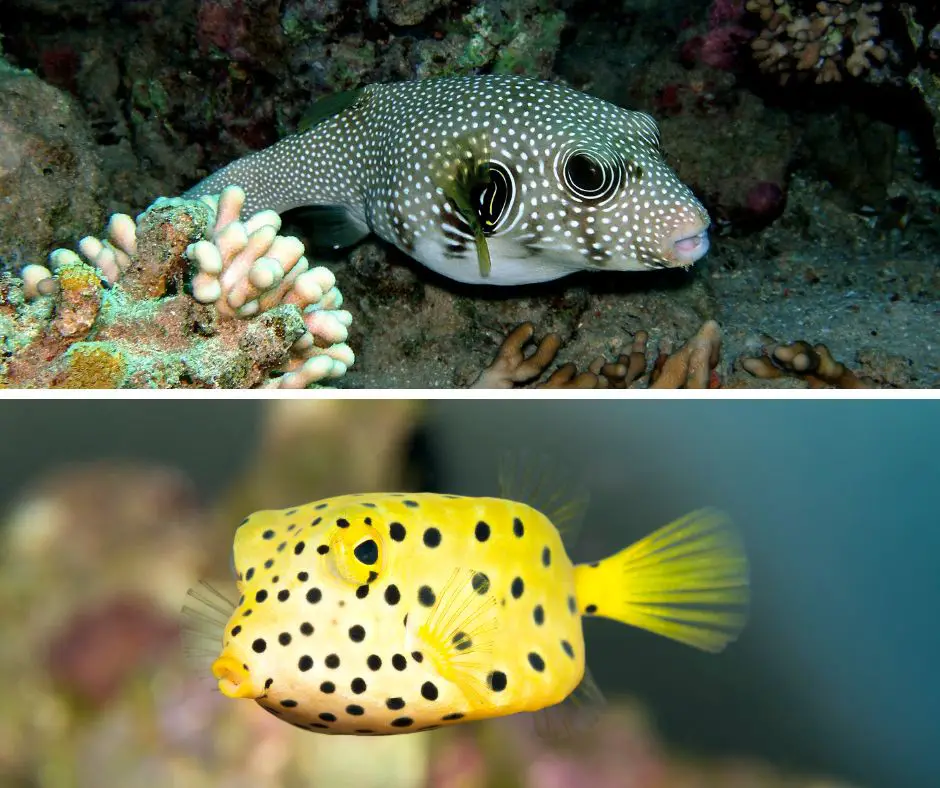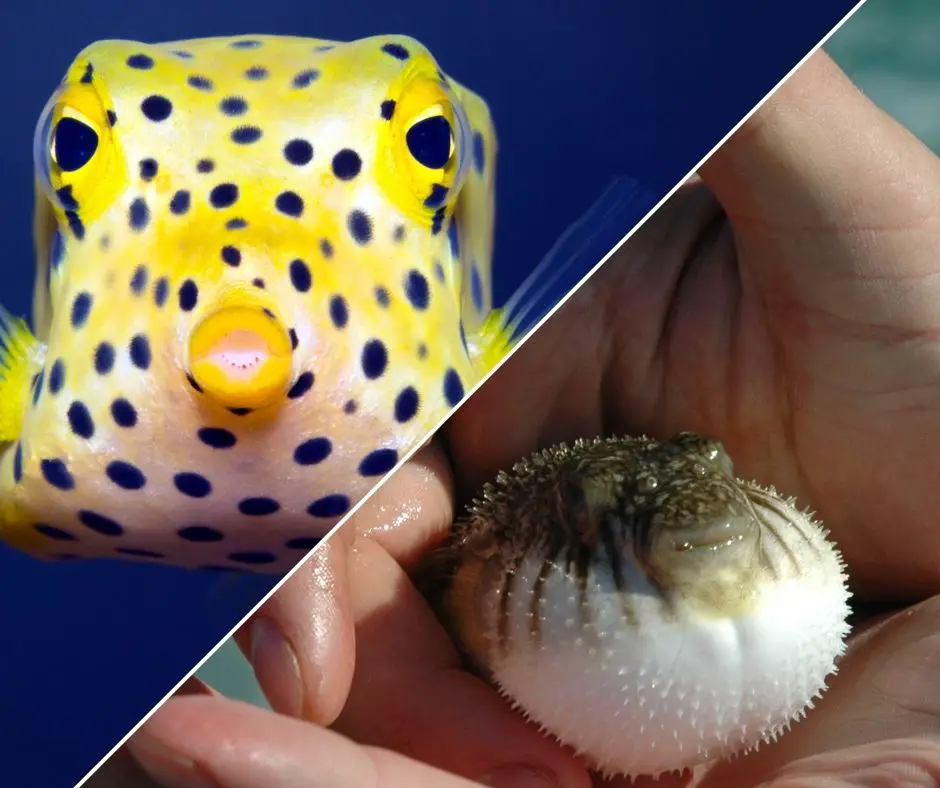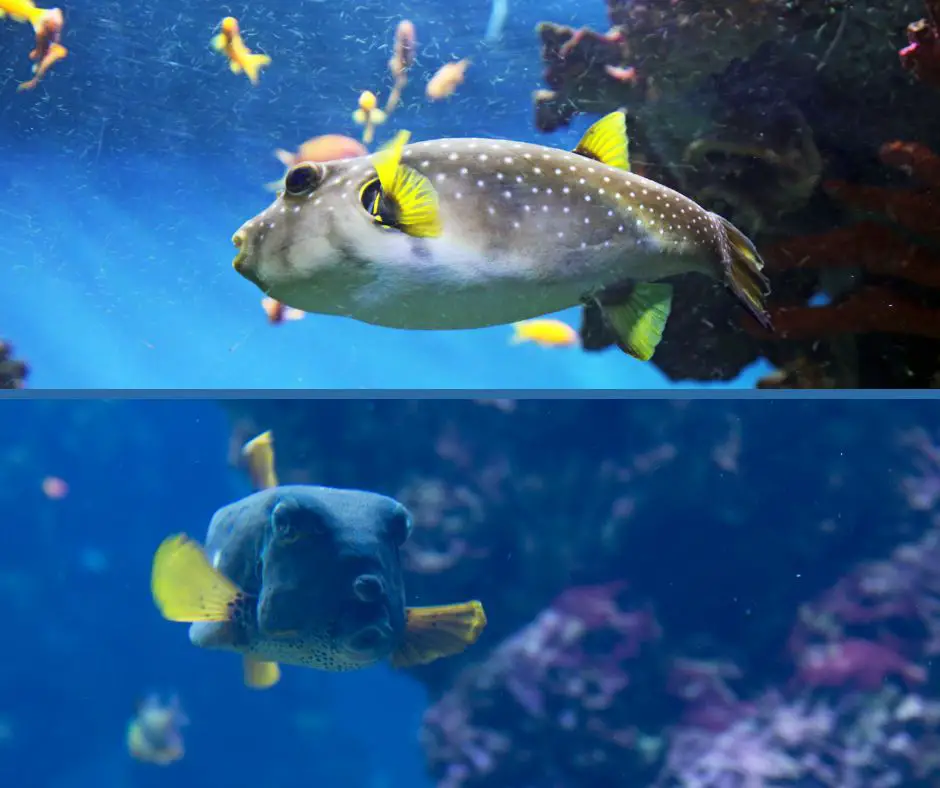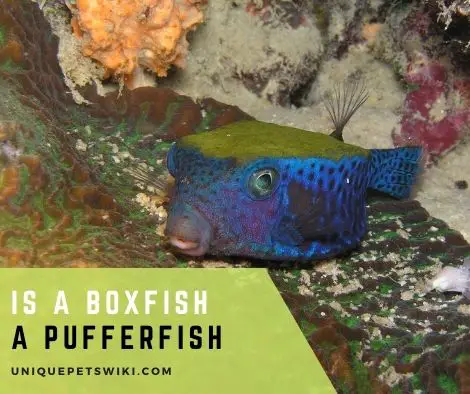Is a boxfish a pufferfish? Many people differ in their views about boxfish and pufferfish; some will tell you that boxfish and pufferfish are the same, while others know they are different fishes.
The confusion is so extreme that most people who mistake boxfish with pufferfish avoid eating them because they fear being poisoned. Yes, pufferfish contain a deadly poison that can paralyze or kill in a minute.
Can you tell a boxfish and pufferfish apart? Worry no more; you’ll find everything entailing these fishes further in the article.
Contents
Is a Box Fish a Puffer Fish?
No, a boxfish is not a pufferfish; they belong to different families but are cousins. Boxfish are members of the Ostraciidae family and order Tetraodontiformes, while pufferfish are poisonous fishes in the family Tetraodontidae.
Pufferfish and porcupine fish are noticed because of their ability to puff up in a few seconds by swelling water or air when startled or stressed.
They obtain a balloon shape making them larger than usual and extremely difficult for predators to bite.
On the other hand, boxfish show a limited capacity to inflate themselves, only up to 20-30% of their volume.
Boxfishes are famous for their capacity to release ostracitoxin poison in the event of aggression.
In fact, most pufferfish species are exceptionally toxic. When it comes to boxfishes, they release toxins but don’t keep them in the body.
Differences Between Box Fish and Puffer Fish?

Boxfish are the ever-popular cowfish or trunkfish. The common boxfishes are the spotted boxfish, smooth trunkfish, and round belly cowfish.
Pufferfish also have alternative names, including blowfish, balloonfish, or swellfish.
They come in different kinds, where Amazon puffer, Dwarf puffer, Blue-spotted puffer, Valentin’s Sharpnose puffer, and Red-eye puffer are the most common.
It is easy to tell pufferfish and boxfish apart because they vary in physical features, defense mechanisms, and toxicity.
Appearance
Boxfish and pufferfish appear differently in their appearance. Boxfish contain a bony carapace beneath their scale and throughout the body, except on the eyes, fins, low-set mouth, and the tail.
They have fins sticking out from the body but lack dorsal fins.
The bony carapace is what gives these fish a boxy shape, hence their name. This odd shape denies boxfish speedy propulsion and is often not swimming but hovering as some describe it.
When viewing them from the side, boxfish are oval. However, if you look at them from one end, a triangle, square, or pentagon shape is apparent, depending on the species.
Pufferfish have a large round body rather with fins sticking out. All pufferfish have an air sack capable of inflating when they feel threatened. They also contain four front teeth that fuse to form a sharp beak.
Aside from these features, pufferfish have distinct spines; some are covered in delicate spines, and others have harsh spines.
Defense Mechanism
Pufferfish are willing and ready to attack any person or animal they perceive as a threat. They are endogenously toxic or, in simple terms, can secrete deadly poison (tetrodotoxin), making them extremely dangerous to consume and touch.
Another survival tactic for pufferfish is their intimidating posture. They puff up by swelling water or air to increase their visual size, and this discourages many predators from approaching them.
Contrastingly, boxfish produce deadly toxins in slimy mucus that oozes from the specialized skin cells all over their body, poisoning marine life within their surroundings.
Because of this, raising boxfish alongside other unsuspecting fish causes potential consequences. Boxfish use their poison protection mechanism to attack anyone that threatens them.
These fish have a limited ability to puff up compared to pufferfish and therefore don’t rely on this tactic.

Toxicity
There is a big difference in the toxicity level of boxfish and pufferfish. Boxfish are not nearly as poisonous as pufferfish. But they have a unique way of defending themselves from predators with poison.
Level of Toxicity in Boxfish
The lethality of poison among boxfish is incredibly different and affects marine life within their vicinity.
For instance, Hawaiian boxfish excrete a very dangerous toxin called ostracitoxin that breaks down or destroys the red blood cells of predatory fish when it gets in their bloodstream.
But the toxin in water is less destructive as it’s quickly diluted to a non-harmful level. Boxfish are good for food. Their toxins can be destroyed through proper cooking, making them safe to eat.
Lethality of Poison in Pufferfish
In contrast, the pufferfish poison has a great destructive capacity. They are the most toxic fish in the world. Pufferfish toxin is exceedingly poisonous and capable of causing paralysis and death even at a very low concentration (less than 2mg).
While you can eat pufferfish, poorly prepared pufferfish flesh can kill people because of the toxin. Cooking doesn’t make the poison relent; hence, it requires skilled and certified chefs to prepare pufferfish for consumption.
Can Box Fish and Puffer Fish Live Together?

No, boxfish and pufferfish cannot live together. Pufferfish are solitary fish and love living alone. Some pufferfish are aggressive towards other fish species and are renowned for fin nipping.
Most pufferfish are predatory fishes; where they eat small fishes and bite the fins of big fishes. To some extent, boxfish are typically peaceful towards other fish species than their fellow mates.
Despite that, it’s not safe to keep a boxfish and pufferfish in one aquarium. The reason is that a puffer can take a nip triggering the boxfish to poison the tank while it’s defending itself. The boxfish toxin can kill pufferfish and even themselves.
Furthermore, pufferfish will puff up anytime they perceive a threat, which is enough reason to scare boxfish. Consequently, the boxfish will poison the tank as a survival mechanism, and both fish will die.
Conclusion
If you own a boxfish and pufferfish, it would be great to keep them separately. Despite being highly toxic, pufferfish are not community fish. They don’t need companies because of their aggression.
Moreover, both fishes are poisonous and sometimes don’t tolerate each other’s poison. They quickly secrete poison whenever they perceive a threat.
The meat of pufferfish and boxfish is edible and tastes good; however, it requires a lot of caution to remove the toxins. Boxfish need proper cooking, and the poison is gone.
However, pufferfish meat is only safe for consumption after removing organs with the toxin, and only highly trained and certified chefs are allowed to do it.
